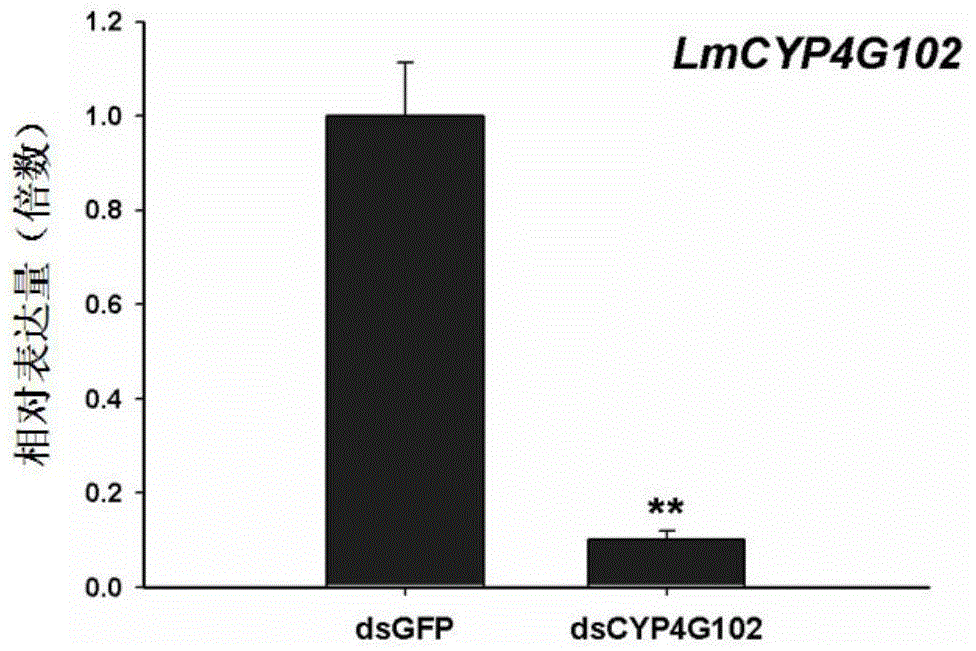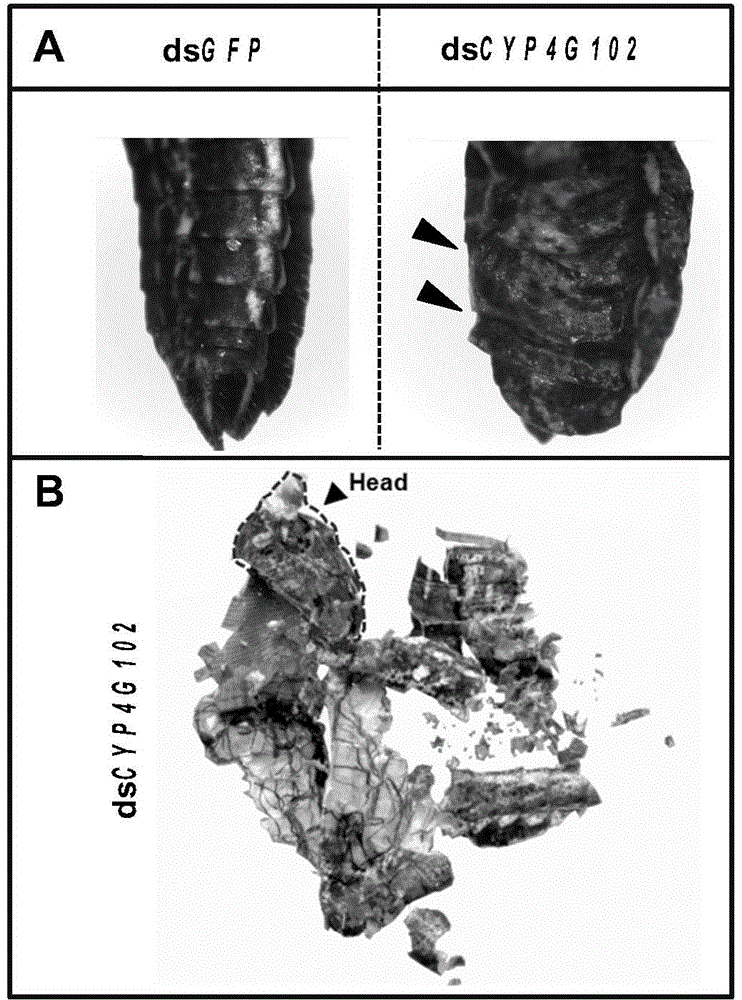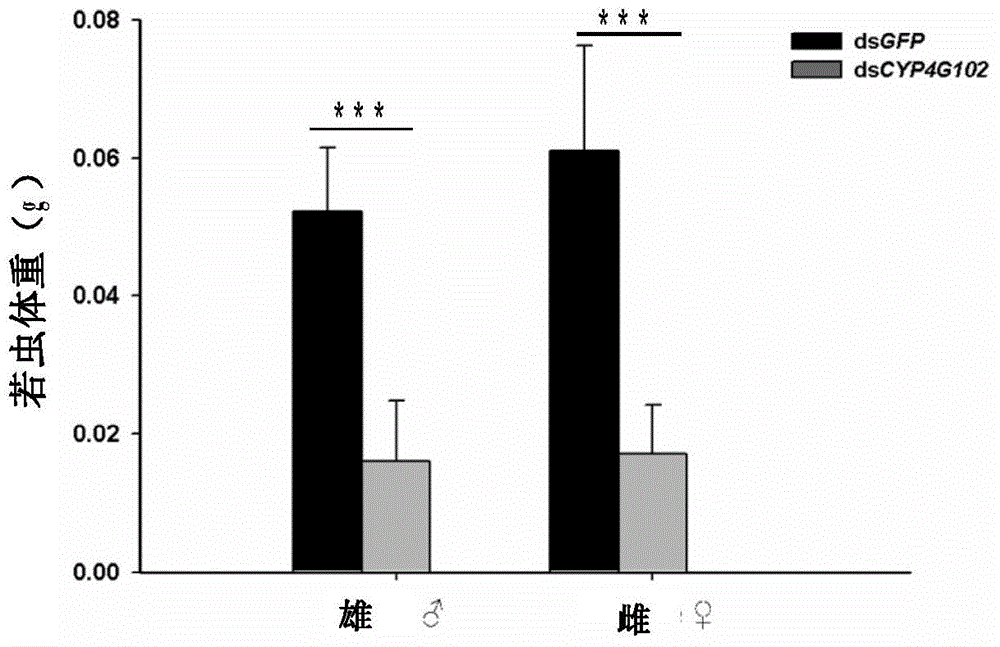Insect cytochrome P450 gene and application thereof
A technology of insect cells and pigments, applied in the fields of application, genetic engineering, plant genetic improvement, etc., can solve problems such as pesticide agricultural production and ecological environment threats
- Summary
- Abstract
- Description
- Claims
- Application Information
AI Technical Summary
Problems solved by technology
Method used
Image
Examples
Embodiment 1
[0015] Example 1: Acquisition of full-length cDNA sequence of migratory locust cytochrome P450 gene
[0016] Based on the migratory locust transcriptome database, bioinformatics methods were used to search the cytochrome P450 genes of migratory locusts, and the partial sequences of related genes were obtained after sequence analysis. The full-length cDNA sequence of the migratory locust cytochrome P450 gene (LmCYP4G102) was obtained by rapid cloning PCR technology at the end of the cDNA. The nucleotide sequence length was 1686bp, encoding 561 amino acids.
Embodiment 2
[0017] Example 2: Acquisition of cytochrome P450 gene fragment and dsRNA of migratory locust
[0018] 1) Obtaining the cytochrome P450 gene fragment of migratory locust
[0019] According to the sequence of the characteristic region of the cytochrome P4504G family, primer premier 5.0 software was used to design specific primers. The sequence of the upstream primer was SEQ ID NO: 4, and the sequence of the downstream primer was SEQ ID NO: 5. All primers were provided by Sangon Bioengineering (Shanghai ) Co., Ltd. Synthesis. Using the plasmid containing SEQ ID NO: 1 as a template, the cytochrome P450 gene fragment of migratory locust was amplified by PCR, and used SV Gel and PCR Clean-Up System (Promega) kit was used to purify the obtained cytochrome P450 gene fragment of migratory locust.
[0020] 2) Synthesis of dsRNA from migratory locust cytochrome P450 gene fragment
[0021] Using the migratory locust cytochrome P450 gene fragment SEQ ID NO: 3 obtained in step 1) as a t...
Embodiment 3
[0022] Example 3: dsRNA synthesis of cytochrome P450 gene fragments to kill migratory locust experiments
[0023] 1. Injection of dsRNA synthesized by migratory locust cytochrome P450 gene CYP4G102 fragment
[0024] The nymphs of migratory locust with uniform size and health status on the second day of the second instar were selected, and a control group injected with dsGFP and an experimental group injected with dsRNA (dsCYP4G102) of SEQ ID NO: 3 were set up. The dsRNA synthesized in vitro was injected into the body cavity of nymphs with a microinjector, the injection volume of dsRNA was 4 μg / head, 60 nymphs in each group, and 3 biological replicates were set up. After the injection, the nymphs were placed in a sarong and raised in an artificial climate box (light:dark time=14h:10h, temperature 30±2°C, humidity 60%), and fed with fresh wheat seedlings.
[0025] 2. Detection of silencing efficiency of migratory locust cytochrome P450 gene
[0026] The nymphs 24 hours after d...
PUM
 Login to View More
Login to View More Abstract
Description
Claims
Application Information
 Login to View More
Login to View More - R&D
- Intellectual Property
- Life Sciences
- Materials
- Tech Scout
- Unparalleled Data Quality
- Higher Quality Content
- 60% Fewer Hallucinations
Browse by: Latest US Patents, China's latest patents, Technical Efficacy Thesaurus, Application Domain, Technology Topic, Popular Technical Reports.
© 2025 PatSnap. All rights reserved.Legal|Privacy policy|Modern Slavery Act Transparency Statement|Sitemap|About US| Contact US: help@patsnap.com



